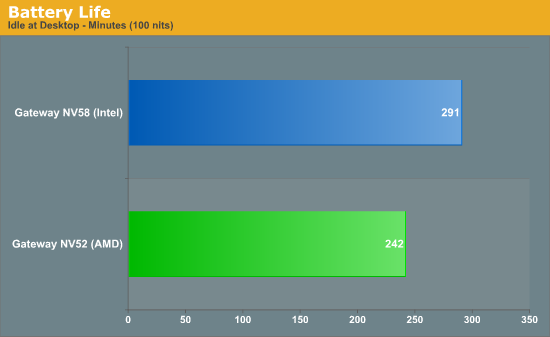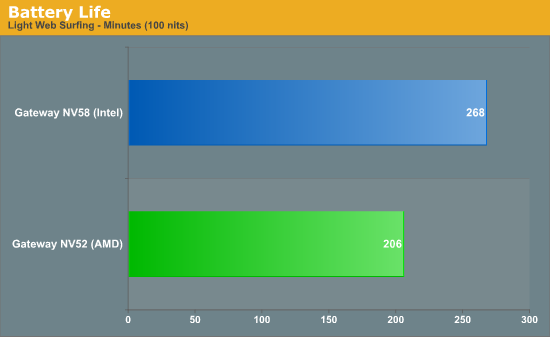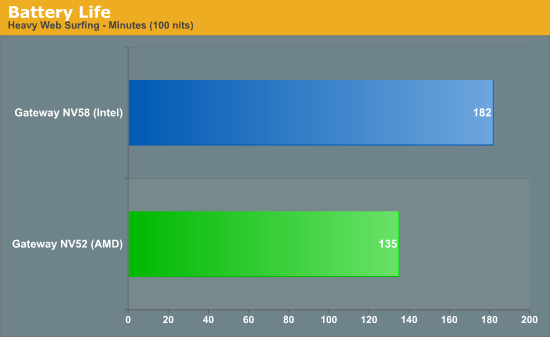AMD vs. Intel: Battery Life Investigated
by Jarred Walton on August 5, 2009 5:00 PM EST- Posted in
- Laptops
AMD vs. Intel: Battery Life Investigated
Both laptops used identical power saving settings under Windows Vista's "Balanced" plan (with some minor tweaks to the defaults on both systems). We ran five different test scenarios, ranging from best-case idle battery life at the Windows desktop to a far more taxing DVD/x264 playback results, along with two different Internet surfing benchmarks. One Internet benchmark represents a "light" load while the other has far more Flash content and represents a "heavy" load. We set both LCDs to 100 nits brightness (40% in this case) and completed a couple charge/discharge cycles to break in the battery before beginning our tests. Here are the results.





Considering these systems are as close as we can get to "identical", AMD takes a real pounding in battery life testing. The closest result (the idle test) has the Intel platform providing 20% more battery life, while the best Intel results (DVD playback and heavy web surfing) give about 35% more battery life. Averaging all five results, the Intel-based NV58 delivered 28% more battery life than the AMD-based NV52. Ouch.
Obviously, despite having identical clock speeds there are some real differences between the two processors. For one, Intel's T6500 is a 45nm part compared to the 65nm QL-64 (not that AMD has 45nm parts yet). We also don't know how much of an impact the various chipset and motherboard components might have. What we do know is that AMD's current mobile processor lineup consists of dual-core CPUs that range from 2.00GHz up to 2.50GHz, with most having a 31W TDP to 35W TDP rating; the TK-42 is a 20W 1.60GHz part and the QL-62 is a 25W 2.00GHz part. Intel on the other hand has many more options. 10W dual-core CPUs are available with clock speeds of 1.06GHz to 1.60GHz; 17W chips have clock speeds ranging from 1.33GHz to 2.13GHz; 25W processors start at 2.26GHz and end at 2.66GHz; and the 34/35W parts cover the gamut from 1.60GHz all the way up to 3.06GHz… and that's just the Core 2 Duo parts! Pentium Dual-Core, Core 2 Quad, and Core 2 Extreme parts are also available to flesh out the spectrum. Then again, some of those parts cost twice as much as the Gateway NV52 just for the CPU.
When Intel released Banias and the Centrino platform in March 2003, they started a revolution in their approach to mobile processor design. Power and efficiency became the focus rather than pure clock speed, and the result has been much better mobile processors when it comes to performance per Watt. Unfortunately for AMD, they appear stuck with the old way of doing things: build a generic architecture and then optimize it for power requirements on mobile chips. Essentially the same core K8 architecture that launched in 2003 continues to power AMD's mobile offerings, and while the ensuing shrink to 65nm has helped there's still a lot of ground to make up. AMD-based laptops are still more than fast enough for most users -- and let's make this clear, a $500 dual-core AMD laptop is tons faster than anything using Intel Atom (though it uses more power, obviously) -- but Intel has the upper hand. It's unfortunate there's not more competition in the mobile processor space, or we might start really start to see prices drop!
For now, if you're looking for an inexpensive laptop (not a netbook), you need reasonable battery life, and you don't care about graphics performance we suggest saving up the extra $50-$100 for an Intel-based system.










80 Comments
View All Comments
snakeoil - Wednesday, August 5, 2009 - link
so this is another 'sort of review'? come on.this happen always when they do an amd review.after the 'sort of review' they come with and update where they say that they commmited a 'mistake' and the amd product have a problem so they think the intel hardware wins.
anyway.
doncerdo - Wednesday, August 5, 2009 - link
If you pit a C2D architecture CPU against an Athlon architecture chip, the results are more than obvious and writing this article is a waste of time. It is the same as testing a P4 notebook against an Athlon notebook for power consumption with no testing one already can guess the results. Wasn't the recent Turion lineup with slipt power planes and core redesign a major reason for improved power consumption on the AMD platform? If so, why test previous generation CPUs?Another reason not to like this previews at AT emotions get in the way of objective testing...we already had a retraction in the morning with the 785G article. I really prefer full articles instead of these "beta" (best way I can describe it) writeups.
Exar3342 - Thursday, August 6, 2009 - link
AMD has ignored the laptop market for a long time and has never really engineered a mobile-only CPU in the same focus as Intel. I don't think anyone would argue that AMD's mobile GPUs are better than Intel's, but when it comes down to standard laptop usage, Intel beats AMD hand's down. Intel has better power management, and has a whole suite of ULV processors that kick the pants off AMD's offerings. AMD needs to get it's head out of their a@@ and realize the mobile market is HUGE, and they are neglecting it.thurston - Wednesday, August 5, 2009 - link
I agree, I don't care for the preview articles either, but it got me to read Anandtech tonight, so I suppose it works for them.coldpower27 - Wednesday, August 5, 2009 - link
Actually AMD uses Athlon 64x2 branding for it's mobile line... take a look here:http://products.amd.com/en-us/NotebookCPUDetail.as...">http://products.amd.com/en-us/NotebookC...=&f6...
http://products.amd.com/en-us/NotebookCPUDetail.as...">http://products.amd.com/en-us/NotebookC...=&f6...
doncerdo - Wednesday, August 5, 2009 - link
I thought mentioning the different power planes would make you realize we are talking about Turion Ultra. Those CPUs with the Lion core for example that start with RM designation and are part of the Puma platform. So my post stands based on the fact that at least this CPUs were redesigned with mobility in mind and were not simply cherry picked low TDP parts.JarredWalton - Wednesday, August 5, 2009 - link
They may have split power planes (didn't AMD already have some issues with that and CnQ on the desktop?) but they're still by and large the same K8 dual-core CPU that we've had for years. As for the "Lion" CPUs, you might want to recheck your information. AFAIK, Althon X2 QL-64 is a "Lion" processor, just like the Turion X2 RM and ZM lines. (Not that http://en.wikipedia.org/wiki/List_of_AMD_Turion_mi...">Wikipedia hasn't been wrong in the past....)mczak - Wednesday, August 5, 2009 - link
Turion Ultra (with Lion core) should have a bit better battery life (despite same TDP) than Athlon X2 mobile (with Lion core) since the former seems to also support (as already mentioned) more power states, deeper sleep, lower min p-state, and adjustable HT frequency. Well, maybe. It should also be slightly faster (because of twice the cache). I'd say all of that would only probably make a marginal difference however.As for 45nm parts, Tigris/Caspian should appear later this year - Caspian just looks like mobile regor to me. Chipset is rather unexciting (rs880m) but I'd guess the cpus (caspian) could have a bit higher frequency with the same power draw than lion (or alternatively same frequency with lower power draw), together with the improved IPC of K10 that could be enough to make them competitive with lower end core2 duo offerings. Not sure why it's not released yet actually, it really looks to me like amd would desperately need this new platform and all ingredients already exist as desktop parts.
JarredWalton - Wednesday, August 5, 2009 - link
The real problem is that on mobile systems, AMD just doesn't appear to have any answer to Core 2. On desktops, there's Phenom II at least, but that's the size of Core i7 so it's no surprise they aren't cramming that into a laptop. AMD's CPU names are also confusing; Turion X2 is higher spec than Athlon X2 on mobile systems, but there's a ton of overlap and unfortunately this is the closest we could get. Still, the only sub-30W CPUs listed at AMD are the Athlon X2 QL-62 (25W) and the Athlon X2 TK-42 (20W).If you look at the http://products.amd.com/en-us/NotebookCPUResult.as..." target="_blank">complete list, all the other dual-core AMD CPUs are 35W TDP except:
Turion X2 ZM-80 (32W)
Turion X2 RM-70 (31W)
Turion X2 TL-56 (31W/33W)
Turion X2 TL-58 (31W)
The most attractive based off specs would have to be the QL-62, considering the 25W rating vs. 31-35W, so despite the higher performance designs in most instances I'm not sure the Turion line is universally better. If I can get a ZM-80, I'll try to install it in the NV52 and see what it does for power/battery results. Even if it can improve battery life, the T6500 is still about 30-35% faster, and T6500 isn't even remotely high-end.
K6III - Thursday, August 6, 2009 - link
It seems that bringing the Athlon II to the mobile market makes a lot of sense. 45nm and smaller core than existing Athlon64 X2, many of the same performance enhancements as PhenomII, and potentially similar/lower power draw compared to Core2.